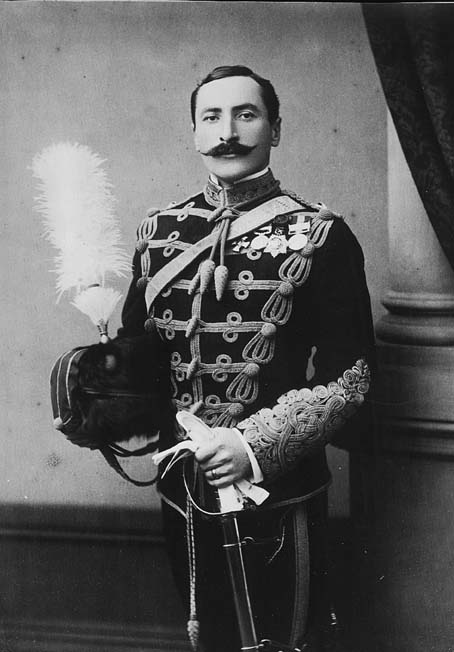
Auction: 4004 - Orders, Decorations, Campaign Medals & Militaria
Lot: 10
A Rare 'Defence of Chitral' D.S.O. Group of Eight to Lieutenant Colonel H. K. Harley, 7th Hussars, Late 14th Sikhs a) Distinguished Service Order, V.R., silver-gilt and enamel, with top riband bar, small flaking to white enamel b) India General Service 1895-1902, one clasp, Defence of Chitral 1895 (Lieutt. H.K. Harley 14th Sikhs) c) Queen's Sudan unnamed d) Queen's South Africa, five clasps, Cape Colony, Orange Free State, Transvaal, South Africa 1901, South Africa 1902 (Bt. Major D.S.O. 7/Hrs) e) Turkey, Order of the Medjidieh, fourth Class breast Badge by Spink, London, silver, gold and enamel, with rosette f) Khedive's Sudan, unnamed g) France, Croix de Guerre 1914-17, with star h) Italy, Medal for Military Valour, bronze, good very fine or better, the group mounted as worn (8) Estimate £ 8,000-10,000 D.S.O. London Gazette 16.7.1895 Henry Kellett Harley, Lieut., Indian Staff Corps. 'In recognition of services during the recent operations in Chitral'. Details also given in later London Gazette 27.8.1895 'The Queen has been graciously pleased to give orders for the following appointment to the Distinguished Service Order, in recognition of the services of the undermentioned Officer during the recent operations in Chitral.' Subterfuge at Chitral The historically volatile area of Chitral was thrown into politcal turmoil in January 1895, by the fratricide committed against the then Mehtar, Nizam-ul-Mulk. His half brother, Amir-ul-Mulk arranged for a shooting 'accident' to occur on the first day of that month and Amir, with his rival now out of the way, immediately demand from Mr Gurdon (the British Political Agent in Chitral) that he be recognised as Mehtar. Gurdon, obviously placed in a difficult position, argued that he did not have the authority to make decisions on behalf of the Indian Government and successfully requested fifty Sikhs to be sent from Mastuj, under the command of Lieutenant Harley, 'a light-hearted, young Irishman of gregarious instincts'. On the 25th January, George Robertson (Senior British Political Agent) arrived at Mastuj, having heard the previous day, that Umra Khan had crossed into Chitral with 4,000 men with the purpose of making mischief. The pressing danger for Gurdon was becoming more apparent, and Robertson decided to force march to Chitral with two detachments, the first under Captain C.V.F.Townshend, whilst Harley commanded the second, consisting of thirty-three Sikhs and one hundred Kashmir Rifles. The force arrived at the fort on the 31st January. In Robertson's eyes, Amir was a weak man while Umra Khan was not acceptable to the Indian Government, so he invited Sher Afzul into Chitral. Although the latter was seen as the only realistic candidate for Mehtar, he came to Chitral with an unacceptable condition-that all British and Europeans should leave the area. With rumours rife that Sher Afzul had arrived in the area with troops, it was decided that a reconnaisonce of the Chitral plain would be made. On 3 March two hundred Kashmir Rifles split into two parties were sent out; one under Captain C.P. Campbell and Townshend, the other under Captain J. Baird and Gurdon. Baird' s party to their cost were quick to confirm that the rumours were true. They met a hostile force on unfavourable ground, and Baird was mortally wounded. Meanwhile Campbell and Townshend came upon a hamlet in which they saw enemy movement. They advanced on the position, confident in receiving support from Baird's troops should the situation get out of hand. Ignorant of the fate that had befallen Baird, Townshend's force also suffered casualties, including Campbell who received a bullet in his knee cap. Harley, who had been left with his party of Sikhs to hold the fort, was now summoned at 6pm to lead his men out and cover, what was now turning into a desperate and frantic retreat. His men stood firm in the enclosing darkness and offered volley fire to the pursuing enemy. The retreating men reached the relative safety of the fort having suffered 30 per cent casualties in the action. The Siege of Chitral The 3rd March 1895 saw the begining of a siege which was to last until Kelly's relief force arrived on the 20th April. Over the coming weeks the enemy forces steathily approached the walls of the fort, under the protection of bullet proof sangars. The four hundred and three riflemen trapped in the fort had to endure a mixture of bad weather, begat fever and dysentery By the 24th March, after three weeks of the siege, the defenders had suffered nineteen casualties. The enemy on the other hand, safely encamped behind their sangars and due to a need on the British part to conserve ammunition, had hardly suffered a casualty. On the morning of the 6th April the enemy, having created a sangar within thirty yards of the wall, set fire to the gun-tower of the fort. The gun-tower had been targeted, due to its high timber content. The blaze was particulary difficult to put out, as in order to reach the flames at the base of the tower the defenders had to rise above the cover of the walls and expose themselves to heavy fire from the enemy entrenched behind the sangars. In this respect Harley's Sikhs behaved valiantly. By 9.30am the fire which had raged for some five hours, was finally under control and nearly extinguished. At the end of the 5th week of the siege, there were now eighty-five patients in the hospital. The enemy spent the next week adding to the general confusion by drumming, chanting and shouting abuse at the besieged. An attack was expected, but did not materialise. However, the reason for this supposed inaction became all too clear on the morning of the 17th, when mining was heard underneath the gun-tower. Harley Saves the Fort Robertson decidedthat a counter sortie must be sent out with explosives in an effort to destroy the mine shaft, 'the forlorn hope was to be made up of forty Sikhs, under their own Jemadar, and sixty Kashmir Riflemen, the whole to be led by young Harley.' The summer-house, believed to be the entrance of the mine shaft, was expected to be strongly fortified. At 4pm Harley set out from the fort , 'there was to be no firing till the post was carried - nothing but white steel.' The enemy, although caught by suprise, managed to unleash a volley in the faces of the advancing troops, killing two and severely wounding another. Fearsome bayonet work on the part of the Sikhs soon cleared the enemy around the entrance of the mine, but more of Sher Afzul's men entered into the fray, pouring down heavy fire on Harley's position. The fury of the fight was not lost on the individuals in the fort, 'The Sikhs in the hospital came crawling out, seized rifles, and crept onto the parapets. Several of them had lost half their feet from frost-bite, and were obliged to hobble sideways.....All alike were full of battle madness and shouting with joy at the prospect of a fight in the broad day, and to support their "brothers" outside' Harley and his men set about clearing the mine shaft of enemy workers; in all about twenty were dispatched at the point of the bayonet, while Harley saved two to be kept as prisoners. Assuming that the mine was now clear, Harley set the explosives a few feet inside the mouth of the shaft. While he was tamping the fuses another two Chitralis came running out of the shaft, and in the confusion trampled the gunpowder hose, rendering it useless. As Harley was about to fit a spare hose, 'a violent explosion occurred, knocking him down and burning the turbans of the Sepoys'. The powder bags had prematurely exploded, leaving Harley's party with no option but to retreat. They were forced to make a mad dash across the last twenty yards of open ground, where once again they were exposed to the enemy's vicious rifle assault. Lieutenant Harley, the consummate Officer, was last back into the fort bringing his prisoners with him. Out of the original one hundred men that had set out on the sortie, twenty-one were now casualties. The Chitralis had lost forty to fifty killed, thirty-five of which had been bayonetted in and about the mine shaft. More importantly, the tunnel leading to the gun-tower had collapsed. Harley's success had not only saved the fort in the short term, but also struck a mortal blow to the morale of Sher Afzul's forces. The latter could no longer induce his men to attempt a full frontal assault on the fort. The fierce spirit displayed by Harley's party, combined with the news that a relief force from Gilgit was now nearing Chitral, heralded the end of the siege for Sher Afzul. The enemy forces dispersed, and Kelly's relief force arrived at the fort on the 20th April. (Extracts taken from Chitral, by Sir George Robertson K.C.S.I.) Lieutenant - Colonel Henry Kellett Harley D.S.O., born 1868, descendant of Robert Harley, Earl of Oxford; gazetted Second Lieutenant, Royal Dublin Fusiliers 1890; transferred to Indian Staff Corps 1892; took part in the defence of the Fort of Chitral; commanded the British Agents' Escort (D.S.O.; Mentioned in Despatches); Captain 1898; Brevet Major 1898; served in the Nile Expedition 1898, severely wounded at the battle of Atbara (Mentioned in Despatches London Gazette, 24.5.1898); Captain Dorsetshire Regiment 1900; Captain 7th Hussars1900; Adjutant, Imperial Yeomanry 1905-1908; Adjutant, Territorial Force 1908; retired 1909; re-joined in the Great War, served in France 1916-17, Major in the Royal Field Artillery and Royal Garrison Artillery (Mentioned in Despatches); Lieutenant Colonel 1919; on the Staff of the British Mission, G.H.Q., Italy; Lieutenant Colonel Harley died of gas poisoning 9.1.1919.
Sold for
£12,000




